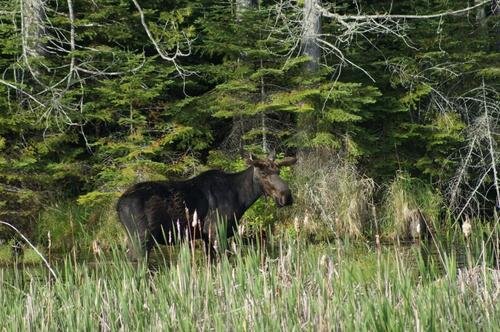Twenty-three percent of collared moose that died in Northeastern Minnesota over the past 15 years were infected with Parelaphostrongylus tenuis, a brain worm parasite transmitted by white-tailed deer that is one of the biggest threats to adult moose mortality in Minnesota.
A new study from the University of Minnesota College of Veterinary Medicine and the Grand Portage Band of Lake Superior Chippewa published today in the journal Science Advances offers a new theory on the role of wolves in disease transmission among prey.
The study was conducted in and around the Grand Portage Band of Lake Superior Chippewa Indian Reservation in Northeastern Minnesota and in the northern superior uplands forest along the northwest Lake Superior shoreline, where the UMN and Grand Portage team have for years been studying moose in an effort to understand and reverse a long-term moose population decline. Researchers captured and tracked 94 adult moose, 89 deer (65 adults) and 47 adult wolves during the 2007–2019 study period.
The study found that:
Most deer and moose performed seasonal migration, with different habitat selections by the two species.Deer and moose overlap increased during the spring migration and summer seasons—a time of greatest brainworm transmission risk.Wolf pressure was linked to greater segregation of deer and moose across habitats—and reduced brainworm transmission risk.
“We often think of wolves as bad news for moose because they kill a lot of calves,” said principal investigator Tiffany Wolf, DVM, Ph.D., an assistant professor in the Department of Veterinary Population Medicine. “But this suggests that wolves may provide a protective benefit to adult moose from a parasite-transmission perspective. Because brainworm is such an important cause of adult moose mortality in Minnesota, we can now see that the impact of wolves on moose is a bit more nuanced.”
The findings give state and tribal managers new information to consider in drafting and implementing herd and wolf management plans in Minnesota and beyond. Maintaining healthy moose populations is a central goal of tribal managers, as moose are an important subsistence species for the Grand Portage Band and important to cultural preservation.
Key to the study were Seth Moore, co-principal investigator of the project. Edmund Isaac and Yvette Chenaux-Ibrahim, of the Grand Portage Band; Luiz Gustavo Oliveira-Santos, of the Federal University of Mato Grosso do Sul, Brazil, who provided spatial ecology expertise; Virginia Tech assistant professor Luis Escobar, in the Department of Fish and Wildlife Conservation; William Severud and Tyler Garwood in the VPM department; and James Forester in the University’s Department of Fisheries, Wildlife, and Conservation Biology.
More information:
L. Gustavo R. Oliveira-Santos et al, Spatial compartmentalization: A nonlethal predator mechanism to reduce parasite transmission between prey species, Science Advances (2021). DOI: 10.1126/sciadv.abj5944
Provided by
University of Minnesota
Citation:
Research indicates that wolves might help moose avoid acquiring a deadly deer parasite (2021, December 22)



